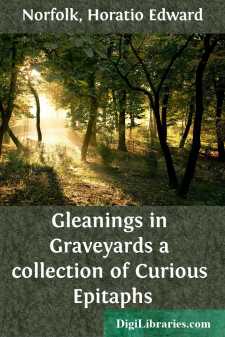Categories
- Antiques & Collectibles 13
- Architecture 36
- Art 48
- Bibles 22
- Biography & Autobiography 813
- Body, Mind & Spirit 142
- Business & Economics 28
- Children's Books 17
- Children's Fiction 14
- Computers 4
- Cooking 94
- Crafts & Hobbies 4
- Drama 346
- Education 46
- Family & Relationships 57
- Fiction 11829
- Games 19
- Gardening 17
- Health & Fitness 34
- History 1377
- House & Home 1
- Humor 147
- Juvenile Fiction 1873
- Juvenile Nonfiction 202
- Language Arts & Disciplines 88
- Law 16
- Literary Collections 686
- Literary Criticism 179
- Mathematics 13
- Medical 41
- Music 40
- Nature 179
- Non-Classifiable 1768
- Performing Arts 7
- Periodicals 1453
- Philosophy 64
- Photography 2
- Poetry 896
- Political Science 203
- Psychology 42
- Reference 154
- Religion 513
- Science 126
- Self-Help 84
- Social Science 81
- Sports & Recreation 34
- Study Aids 3
- Technology & Engineering 59
- Transportation 23
- Travel 463
- True Crime 29
Gleanings in Graveyards a collection of Curious Epitaphs
Description:
Excerpt
Bedfordshire.
COLMWORTH.
Here is a magnificent monument, erected in 1611, by Lady Dyer, in memory of her deceased husband, Sir William Dyer, the inscription upon which tells us that âthey multiplied themselves into seven children.â Beneath are the following quaint lines:â
My dearest dust, could not thy hasty day
Afford thy drowsy patience leave to stay
One hour longer, so that we might either
Have set up, or gone to bed together!
But since thy finished labour hath possessed
Thy weary limbs with early rest,
Enjoy it sweetly, and thy widow bride
Shall soon repose her by thy slumbering side!
Whose business now is to prepare
My nightly dress and call to prayer.
Mine eyes wax heavy, and the days grow old,
The dew falls thickâmy blood grows cold:â
Draw, draw the closed curtains, and make room,
My dear, my dearest dust, I come, I come.
EDWORTH.
Here lies father, and mother, and sister, and I,
We all died within the space of one year,
They be all buried at Whimble except I,
And I be buried here.
LUTON.
In the âWenlock Chapelâ in the above church, on an embattled altar-tomb is a recumbent figure of a priestârepresenting William Wenlock, who died 1392. Round the verge of the tomb is inscribed, in ancient characters,â
. . . . Ilemus hic tumulatus de Wenlock natus; in ordine presbiteratus; alter hujus ille: dominus meus fuit ville: hic jacet indignus: anime Deus esto benignus!
On the side of the tomb,â
In Wenlock brad I: in this town lordshcippes had I! here am I now lady: Christes moder help me lady. Under these stones: for a tym shal I rest my bones; deyn mot I ned ones. Myghtful God graât me thy woues. Ameâ.
Formerly in a window of this chapel was a portrait of Wenlock, with the following inscription:â
Jesu Christ, most of might,
Have mercy on John de Wenlock, knight,
And of his wife Elizabeth,
Which out of this world is passed by death,
Which founded this chapel here,
Help thou them with your hearty prayer,
That they may come unto that place,
Where ever is joy and solace.
On an altar-tomb in the tower is the following:â
Thomas Gilbert here doth stai
Waiting for Godâs judgment day,
Who died August 25, 1566.
A slab on the floor of the south aisle bears this inscription,â
Here lyeth the body of Daniel Knight,
Who all my lifetime lived in spite.
Base flatterers sought me to undoe,
And made me sign what was not true.
Reader take care, wheneâer you venture
To trust a canting false dessenter,
Who died June 11th, in the 61st year of his age,
1756.
A friend of Daniel Knight (at whose instigation the above epitaph was engraved during his lifetime, and the future tombstone used as a cupboard door) prepared an inscription for his own tomb,â
âHere lies the body of Thomas Proctor
Who lived and died without a doctor.â
But fate, jealous of the reputation of the faculty, broke his leg, and compelled him to sacrifice to ?sculapius.
BUCKLEBURY.
Here lyeth the body of Samuel Wightwicke, Esqre. 1662.
Heaven only knowes the Blisse his soul inioyes,
Whilâs wee on earth seeke after fading toyes,
And doe not mind how saints and angells singe
To see him thronâd with his eternall king....


